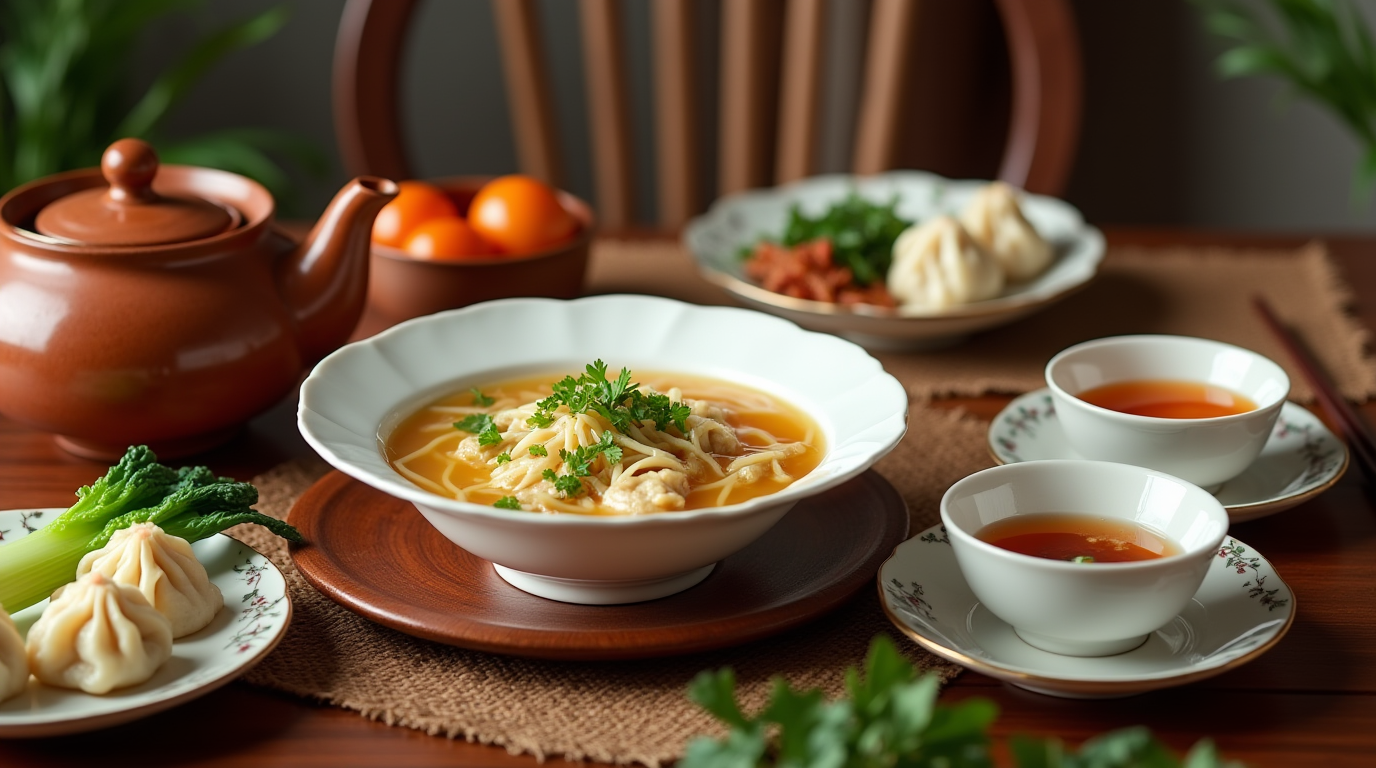Authentic Wonton Noodle Soup Recipe – Warm, Savory & Comforting
You’re about to embark on a culinary journey to China with a traditional wonton noodle soup recipe that’s both nourishing and flavorful. This beloved dish is a staple in Chinese cuisine, offering a comforting blend of delicate wontons and savory broth served with springy noodles.
Imagine savoring a steaming bowl of Chinese comfort food that’s been perfected over generations. Our authentic recipe guides you through the process, ensuring that you can recreate this cherished meal in the comfort of your own kitchen.
Key Takeaways
- Discover the secrets to making an authentic wonton noodle soup recipe.
- Learn about the cultural significance of this dish in Chinese cuisine.
- Find out how to prepare a delicious and comforting meal.
- Explore the ingredients and steps involved in the recipe.
- Get tips on customizing the dish to your taste.
The Rich History of Wonton Noodle Soup
As you explore the world of Asian cuisine, you’ll discover that wonton noodle soup is more than just a meal – it’s a cultural phenomenon. This beloved dish has a rich history that is deeply intertwined with the culinary traditions of Southern China.
Origins in Southern Chinese Cuisine
Wonton noodle soup originated in the southern provinces of China, where it was cherished as a comforting, nourishing meal. The dish was often served at family gatherings and celebrations, further cementing its place in the local culture. “Wonton noodle soup is a quintessential representation of Cantonese cuisine,” notes a culinary historian. “Its preparation and consumption are steeped in tradition.”
Evolution into a Global Comfort Food
As Chinese immigrants traveled the world, they brought their culinary traditions with them, introducing wonton noodle soup to new regions and cultures. Today, this dish is enjoyed not only in China but also in restaurants and homes worldwide, adapting to local tastes while retaining its core essence. The versatility of wonton noodle soup has contributed to its global popularity, making it a street food favorite in many countries.
What Makes an Authentic Wonton Noodle Soup
To understand what makes wonton noodle soup authentic, one must delve into the traditional methods of preparation and the regional variations that exist. Authenticity in wonton noodle soup is not just about following a recipe; it’s about understanding the cultural and culinary heritage behind the dish.
Key Components of Traditional Recipes
Traditional wonton noodle soup recipes are characterized by a few key components. First, the wontons themselves are typically filled with a mixture of pork and shrimp, wrapped in a thin dough wrapper. The broth is another crucial element, made by simmering pork bones, chicken, and various aromatics for an extended period. Finally, the noodles are usually thin, wheat-flour noodles that are cooked to a perfect texture.
As noted by culinary expert, “The art of making wonton noodle soup lies in the balance of flavors and textures.”
“A good wonton noodle soup is like a symphony, where each component complements the others to create a harmonious dish.”
Regional Variations Across China
Regional variations of wonton noodle soup across China are vast and diverse. In the south, particularly in Guangdong province, the soup is often lighter and clearer, with a focus on the freshness of the ingredients. In contrast, northern China prefers a heartier, more robust version, sometimes using lamb or beef in the broth.
- In Sichuan province, wonton noodle soup is known for its spicy broth and generous use of Sichuan peppercorns.
- In Shanghai, the soup is often served with a side of pickled vegetables, adding a tangy contrast to the rich flavors.
These regional variations not only reflect local tastes but also contribute to the richness and diversity of wonton noodle soup as a whole, making it a truly authentic and varied culinary experience.
Essential Ingredients for Perfect Wonton Noodle Soup
The foundation of a delicious wonton noodle soup lies in its essential ingredients. To create an authentic and mouth-watering dish, you need to carefully select the right components.
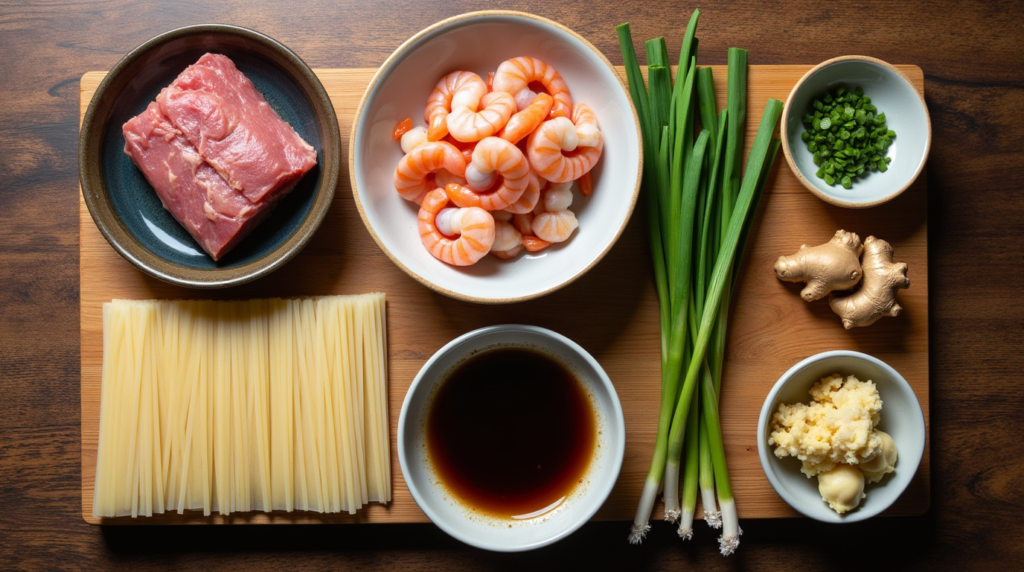
Selecting the Right Wonton Wrappers
When it comes to wonton wrappers, you have the option of using either store-bought or homemade wrappers. Store-bought wrappers are convenient and save time, but making your own wrappers from scratch can add a personal touch to your dish. Look for wrappers that are thin and pliable, as they will be easier to wrap and cook evenly.
Choosing Quality Noodles
The type of noodles you choose can significantly impact the overall texture and flavor of your wonton noodle soup. Opt for quality noodles that are made from wheat flour and have a springy texture. You can choose between thin or thick noodles, depending on your personal preference.
Protein Options for Fillings
The filling is a crucial component of wontons, and you can choose from a variety of protein options. Traditional fillings often include pork, shrimp, or a combination of both. For a vegetarian alternative, you can use tofu or a mixture of finely chopped vegetables.
Aromatics and Seasonings
Aromatics and seasonings play a vital role in enhancing the flavor of your wonton noodle soup. Common aromatics include ginger, garlic, and green onions, while soy sauce, sesame oil, and salt are used to season the broth. You can adjust the seasonings according to your taste preferences.
| Ingredient | Description | Tips for Selection |
|---|---|---|
| Wonton Wrappers | Thin sheets of dough used to wrap fillings | Choose wrappers that are thin and pliable |
| Noodles | Wheat flour noodles with a springy texture | Opt for quality noodles with the right texture |
| Protein Fillings | Pork, shrimp, tofu, or mixed vegetables | Select based on dietary preferences and flavor |
| Aromatics | Ginger, garlic, green onions | Use fresh aromatics for the best flavor |
By carefully selecting these essential ingredients, you can create a wonton noodle soup that is both authentic and delicious.
Making the Perfect Wonton Filling
Crafting the perfect wonton filling is an art that requires precision and patience. The filling is the heart of the wonton noodle soup, and its quality can make or break the dish. To create a delicious and balanced filling, you need to choose the right ingredients and season them properly.
Classic Pork and Shrimp Filling
A traditional wonton filling is made with a combination of ground pork and shrimp. This classic mixture provides a rich, savory flavor and a tender texture. To make this filling, you’ll need to finely chop the shrimp and mix it with ground pork, along with some aromatics like garlic and ginger. Using fresh, high-quality ingredients is crucial to achieving the best flavor.
The ratio of pork to shrimp can be adjusted according to your preference, but a common starting point is a 2:1 ratio of pork to shrimp. You can also add other ingredients like chopped water chestnuts or scallions to enhance the texture and flavor.
Vegetarian Alternatives
For those who prefer a vegetarian or vegan diet, there are plenty of alternatives to traditional pork and shrimp filling. You can use a mixture of finely chopped mushrooms, tofu, and vegetables as a substitute. Shiitake mushrooms are particularly popular for their rich, earthy flavor.
To make a vegetarian wonton filling, you can sauté the mushrooms and other vegetables with some garlic and ginger, then mix them with tofu and seasonings. This filling can be just as flavorful and satisfying as its meat-based counterpart.
Seasoning Your Filling Properly
Regardless of the ingredients you choose, seasoning is key to making a great wonton filling. You’ll need to balance salty, sweet, and umami flavors to create a harmonious taste experience. Soy sauce, sesame oil, and oyster sauce (or vegetarian alternatives) are common seasonings used in wonton fillings.
- Soy sauce for salty, umami flavor
- Sesame oil for a nutty, aromatic flavor
- Oyster sauce (or vegetarian alternatives) for depth and richness
- Sugar or other sweeteners to balance the saltiness
Taste your filling as you go and adjust the seasoning accordingly. Remember, the filling should be flavorful but not overpowering, as it will be served in a savory broth.
Mastering the Art of Wonton Folding
Folding wontons is a skill that, once mastered, will elevate your homemade wonton noodle soup. It’s a technique that requires a bit of practice, but with the right guidance, you’ll be folding like a pro in no time.
Step-by-Step Folding Techniques
To fold wontons effectively, you’ll need a wrapper and a filling. Place a small spoonful of your chosen filling in the center of the wrapper. Dip your finger in a small amount of water and run it along the edges of the wrapper. This will help the wrapper stick together when sealed.
Fold the wrapper into a triangle by bringing two opposite corners together, ensuring the filling is sealed inside. Then, bring the two remaining corners together, pressing them firmly to seal the wonton.
| Folding Technique | Description |
|---|---|
| Triangle Fold | Fold the wrapper into a triangle, sealing the filling inside. |
| Corner Press | Press the corners together firmly to ensure a tight seal. |
Common Mistakes to Avoid
One common mistake is not sealing the wonton properly, leading to the filling escaping during cooking. Another is overfilling, which can cause the wonton to burst open.
Practice Tips for Beginners
Start with a small amount of filling and practice folding until you feel comfortable with the technique. It’s also helpful to watch video tutorials to get a better understanding of the folding motion.
By mastering the art of wonton folding, you’ll be able to create delicious, authentic wonton noodle soup that will impress your family and friends.
Creating a Flavorful Broth From Scratch
A good Wonton Noodle Soup starts with a deep, savory broth that warms the soul. You, the cook, play a crucial role in crafting this broth, and it’s easier than you think. The process involves selecting the right ingredients, employing slow-simmering techniques, and finally, clarifying and seasoning your broth to perfection.
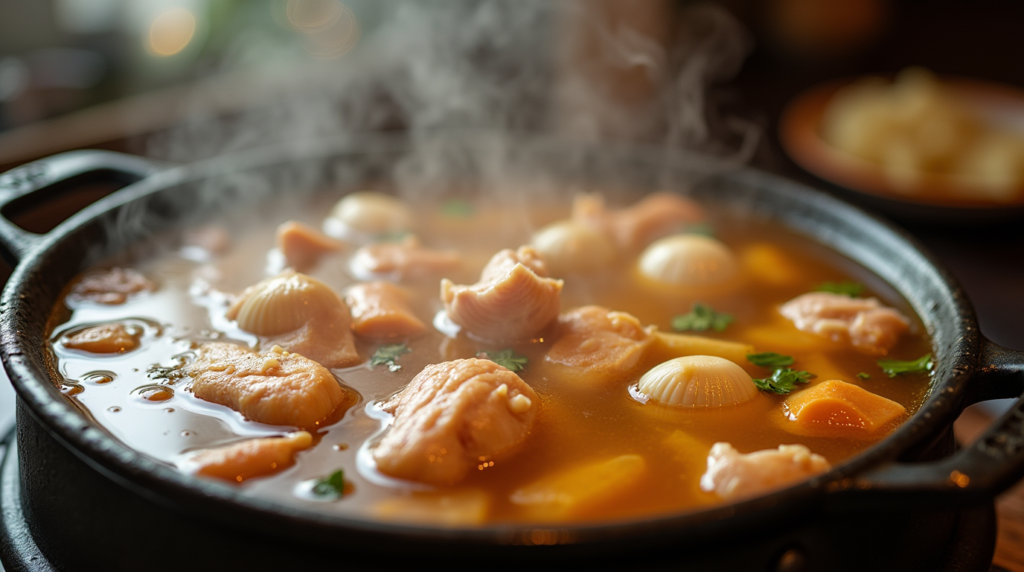
Essential Broth Ingredients
The foundation of a great broth lies in its ingredients. You will need a combination of pork bones, chicken bones, or a mix of both for a rich flavor. Additional aromatics like ginger, garlic, and green onions are also crucial. For a clearer broth, it’s advisable to use a mix of bones that have been blanched to remove impurities.
| Ingredient | Purpose |
|---|---|
| Pork/Chicken Bones | Provides richness and depth |
| Ginger | Adds warmth and spice |
| Garlic | Enhances flavor complexity |
| Green Onions | Contributes to aromatic freshness |
Slow-Simmering Techniques
Slow-simmering is the key to extracting flavors from your bones and aromatics. You should simmer your broth on low heat for at least 4-6 hours. This slow process breaks down the collagen in the bones, resulting in a rich, velvety broth. It’s essential to skim off any impurities that rise to the surface during simmering to keep your broth clear.
“The art of making broth is a slow and meditative process, one that requires patience but rewards with depth and complexity.” – Chef’s Wisdom
Clarifying and Seasoning Your Broth
After simmering, you’ll need to clarify and season your broth. Straining the broth through a fine-mesh sieve or cheesecloth removes any remaining impurities. You can then season it with soy sauce, rock sugar, and a touch of sesame oil to enhance the flavor. Taste and adjust the seasoning to your liking.
By following these steps, you’ll be able to create a savory broth that serves as the perfect base for your Wonton Noodle Soup. Remember, the quality of your broth directly impacts the overall taste of the dish, so don’t rush the process.
Complete Wonton Noodle Soup Recipe
The moment you’ve been waiting for – here’s the authentic wonton noodle soup recipe you’ve been craving. This comprehensive guide will walk you through preparing the ingredients, making the wontons, cooking the noodles, and assembling the final dish to create a truly comforting meal.
Preparing the Ingredients
To start, you’ll need to gather and prepare several key ingredients. You’ll need wonton wrappers, a protein of your choice (typically pork or shrimp), aromatics like ginger and garlic, and quality noodles. Freshness matters, so try to use the freshest ingredients available. For the broth, you’ll need chicken or pork bones, along with additional aromatics.
Making the Wontons
Making wontons involves creating a filling with your chosen protein, mixing it with appropriate seasonings, and then wrapping it in wonton wrappers. To wrap wontons, place a small spoonful of filling in the center of a wrapper, moisten the edges with water, and fold the wrapper into a triangle, pressing the edges to seal. Practice makes perfect, so don’t be discouraged by initial attempts.
Cooking the Noodles
Cooking the noodles is a straightforward process. Simply boil them in water until they’re al dente, then drain and set aside. The key is not to overcook them, as they will continue to cook slightly when added to the hot broth.
Assembling the Final Dish
To assemble the wonton noodle soup, place cooked noodles in a bowl, add several wontons, and then pour the hot broth over them. Garnish with green onions and a dash of sesame oil for added flavor and visual appeal. Your wonton noodle soup is now ready to be enjoyed.
By following these steps, you’ll be able to create a delicious and authentic wonton noodle soup that rivals those found in your favorite Chinese restaurants. Happy cooking!
Nutritional Benefits of Wonton Noodle Soup
This traditional Chinese dish is a nutrient-rich meal option that can be part of a balanced diet. Wonton noodle soup combines protein-rich fillings, vegetables, and noodles, making it a wholesome meal choice.
Protein and Nutrient Content
Wonton noodle soup is an excellent source of protein due to its filling ingredients, typically made with pork or shrimp. The broth is rich in vitamins and minerals from the vegetables used, such as ginger and green onions. The noodles provide carbohydrates for energy.
Healthier Preparation Options
- Use lean protein sources like chicken or tofu.
- Incorporate a variety of vegetables to increase the nutrient density.
- Opt for low-sodium broth or seasonings to reduce salt intake.
Dietary Considerations
For those with dietary restrictions, wonton noodle soup can be adapted. Vegetarian and vegan versions can be made by substituting the protein fillings. Gluten-free noodles can be used for those with gluten intolerance.
Storing and Reheating Your Wonton Noodle Soup
Proper storage and reheating are crucial to maintaining the flavor and texture of your wonton noodle soup. Whether you’re dealing with leftovers or preparing meals in advance, understanding the best practices can make a significant difference.
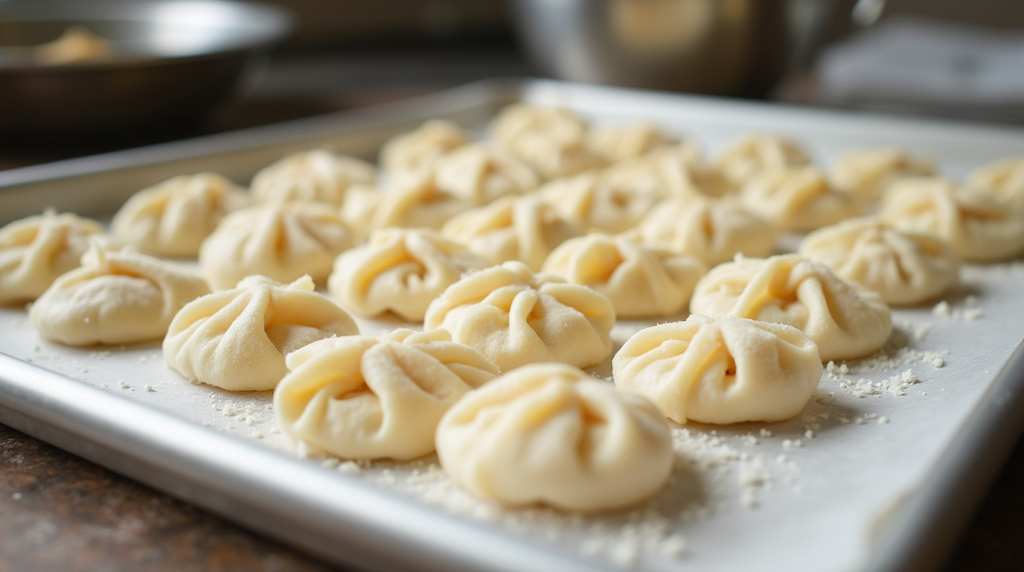
Proper Storage Techniques
To store cooked wonton noodle soup, cool it down to room temperature as quickly as possible to prevent bacterial growth. Once cooled, transfer the soup to airtight containers and refrigerate. The soup can be safely stored in the refrigerator for up to 3 days.
For longer storage, consider freezing the components separately. The broth and noodles can be frozen together, but it’s best to store wontons separately to prevent them from sticking together.
Freezing Uncooked Wontons
Uncooked wontons can be frozen on a baking sheet lined with parchment paper. Once frozen, transfer them to a freezer-safe bag or container for storage. Frozen wontons can be cooked directly in boiling water or broth without thawing.
To prevent the wontons from sticking together, make sure they don’t touch each other on the baking sheet. You can also dust them lightly with cornstarch or flour before freezing.
| Storage Method | Duration | Notes |
|---|---|---|
| Refrigerate Cooked Soup | Up to 3 days | Cool to room temperature before refrigerating |
| Freeze Uncooked Wontons | Up to 3 months | Freeze on baking sheet, then transfer to freezer-safe bag |
| Freeze Cooked Broth and Noodles | Up to 2 months | Store in airtight containers or freezer bags |
Best Practices for Reheating
When reheating, it’s best to heat the broth and noodles together. You can add frozen wontons directly to the hot broth to cook them. If you’re reheating cooked soup, make sure it reaches a rolling boil to ensure food safety.
To maintain the texture of the noodles, avoid overcooking during reheating. If the noodles become too soft, consider cooking a fresh batch to add to the reheated broth.
By following these storage and reheating tips, you can enjoy your wonton noodle soup over multiple meals without compromising on taste or texture.
Serving Suggestions and Pairings
To enhance your meal, consider these traditional serving suggestions and pairings. Wonton Noodle Soup can be the centerpiece of a larger Chinese-inspired meal with the right accompaniments.
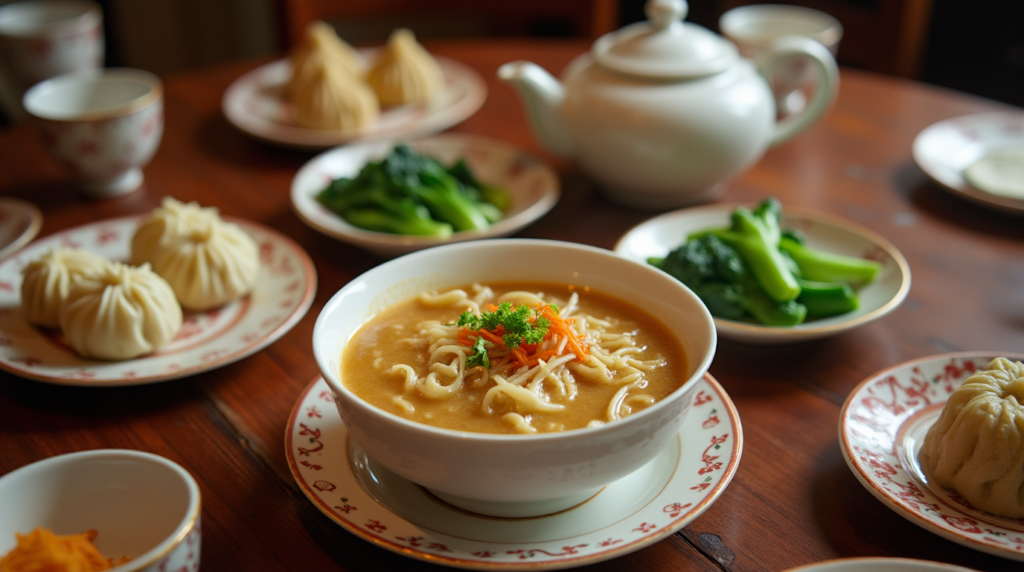
Traditional Side Dishes
Traditional side dishes can elevate your Wonton Noodle Soup experience. Consider serving it with stir-fried bok choy or cucumber salad for a refreshing contrast.
- Stir-fried vegetables
- Pickled mustard greens
- Steamed dumplings
Beverage Pairings
The right beverage can complement the flavors of your Wonton Noodle Soup. Here are some popular pairing options:
| Beverage | Description |
|---|---|
| Chinese tea | Complements the savory flavors |
| Jasmine tea | Adds a floral note |
| Tsingtao beer | Provides a crisp contrast |
Creating a Complete Chinese Meal
To create a complete Chinese meal, balance your Wonton Noodle Soup with dishes that offer contrasting textures and flavors. Consider adding potstickers or spring rolls as appetizers.
Conclusion
You now have the tools to create an authentic wonton noodle soup, a popular noodle dish that embodies the essence of Chinese comfort food. This traditional recipe has been a staple in Chinese cuisine for centuries, and its rich flavors and textures continue to captivate audiences worldwide.
By mastering the art of wonton folding, crafting a flavorful broth, and selecting the right ingredients, you can recreate this beloved dish in the comfort of your own kitchen. Whether you’re seeking a comforting meal or an exciting culinary adventure, wonton noodle soup is sure to satisfy your cravings.
As you explore the world of Chinese cuisine, consider experimenting with different variations and ingredients to make this recipe your own. With its versatility and rich flavor profile, wonton noodle soup is sure to become a favorite in your culinary repertoire.
FAQ
What is wonton noodle soup, and why is it considered a Chinese comfort food?
Wonton noodle soup is a traditional Chinese dish made with wontons filled with meat or shrimp, served in a savory broth with noodles. It’s considered a comfort food because of its warm, soothing, and nourishing properties.
Can I make wonton noodle soup at home, and is it difficult to prepare?
Yes, you can make wonton noodle soup at home. While it requires some effort, the process can be broken down into manageable steps, and with practice, you can master the recipe.
What type of noodles are best suited for wonton noodle soup?
Thin, egg noodles or wonton noodles are typically used in wonton noodle soup. You can choose between fresh or dried noodles, depending on your preference and availability.
Can I customize the filling of my wontons to suit my dietary preferences?
Yes, you can customize the filling to suit your dietary needs. Traditional fillings include pork and shrimp, but you can also opt for vegetarian or other protein sources like chicken or tofu.
How do I store leftover wonton noodle soup, and can I freeze it?
You can store leftover wonton noodle soup in the refrigerator for a few days. To freeze, it’s best to separate the components: freeze uncooked wontons on a baking sheet, then transfer them to a freezer-safe bag, and store the broth and noodles separately.
What are some common variations of wonton noodle soup found in different regions of China?
Regional variations of wonton noodle soup can be found across China, with differences in broth flavor, noodle type, and filling ingredients. Some popular variations include Szechuan pepper-infused broth or Cantonese-style wontons with shrimp and pork.
Can I make wonton noodle soup in advance, and how do I reheat it?
Yes, you can prepare components of wonton noodle soup ahead of time. To reheat, simply cook the noodles and wontons in boiling water, then combine with the hot broth. You can also reheat the broth and noodles separately.
Leave a Review & Rate This Recipe!
There are no reviews yet. Be the first one to write one.

